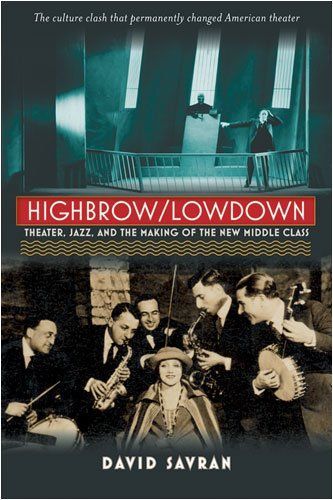
Highbrow/lowdown Theater, Jazz, and the Making of the New Middle Class
Highbrow/Lowdown explores the twentieth century's first culture war and the forces that permanently transformed American theater into the art form we know today. The arrival of jazz in the 1920s sparked a cultural revolution that was impossible to contain. The music affected every stratum of U.S. society and culture, confusing and challenging long-entrenched hierarchies based on class, race, and ethnicity. Jazz was considered the first distinctively American art form, and its dissemination across the globe served to launch the United States as a cultural force to be reckoned with. The Jazz Age was also the era of vaudeville, burlesque, and musical comedy, popular entertainments that were quick to cash in on the jazz craze. But jazz was much more than the music. It was also a powerful cultural force that brought African American, Jewish, and working-class culture into the white Protestant mainstream. When the influence of jazz spread to legitimate theater, playwrights, producers, and critics rushed to distinguish the newly emerging literary theater from its illegitimate cousins. The efforts to defeat the democratizing influences of jazz and to canonize playwrights like Eugene O'Neill triumphed, giving birth to American theater as we know it today. David Savran is Distinguished Professor of Theatre and Vera Mowry Roberts Chair in American Theatre at the Graduate Center, City University of New York. "An important book that raises crucial questions about how and why a literary 'art theatre' came to be seen among tastemakers and canonizers as 'legitimate.' Savran makes the persuasive argument that jazz needed to be defeated in order for the art theatre to take center stage, using an impressive variety of tools to make his case." ---Andrea Most, University of Toronto "Like a canny fight promoter in the perennial American culture wars, David Savran puts the reader ringside for a blow-by-blow account of the Battle of the Brows---high, middle, and low. Setting Jazz Age entertainments at one another, with 'legitimate theater' duking it out with nightclub revues and movies pummeling vaudeville, Highbrow/Lowdown tracks the rise of heavyweight Eugene O'Neill to the top of the card, but it also makes heroes of the referees---the drama critics and audiences who crowned the winners. This is performance history as an innovative 'political economy of culture,' and it's a knockout." ---Joseph Roach, Yale University "A stunningly original analysis of music and theater in the 1920s as inseparable faces of jazz. Savran grounds his social history on a huge array of primary sources while drawing, without fanfare or jargon, on theorists such as Adorno and Bourdieu. His musical analyses of Gershwin, John Alden Carpenter, and George Antheil are not just first class but pathbreaking. No student of jazz as a Western cultural phenomenon---or of any American music or theater in the 1920s---will dare miss this powerfully illuminating, unabashedly reliable, beautifully written book." ---Rose Rosengard Subotnik, Brown University